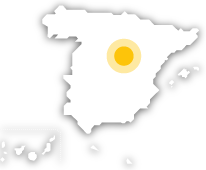
Tejera Negra beech forest

Traces of long ago
The beech trees of Tejera Negra became established in ancient times when the climate was colder and wetter. These trees now find refuge in shady valleys and on northern slopes, with fog, wind, rain and hardly any sun.
Located in the northwest of the province of Guadalajara, in the municipal area of Cantalojas, the Tejera Negra beech forest is one of the southernmost on the continent. It has been awarded the World Heritage designation by UNESCO. It was declared a nature reserve in 1978, although this was revoked with the creation of the enormous Sierra Norte nature reserve in 2011, into which it was incorporate, and which is about 75 times larger. Access is still limited in autumn as it is such a special and delicate environment (see 'Visitor information', below).This unique forest is delimited by the Lillas and Zarzas rivers. The microclimate and isolation of this location have enabled the preservation of the beech groves that give it its name. Along with beech trees, there are other protected species in Castilla-La Mancha, such as yew, holly, birch, oak, hazel and rowan. The undergrowth consists of heather, broom and thickets. The most iconic fauna of the Tejera Negra beech forest are daytime birds of prey such as golden eagles, red kites and goshawks. Roe deer, foxes, wild cats, martens, badgers, weasels, wild boar and nocturnal birds of prey, such as tawny owls, long-eared owls and little owls, abound.
Debe activar Javascript para poder utilizar este servicio
Tejera Negra beech forest
Hayedo de la Tejera Negra Visitor Centre
Carretera al espacio natural, a 2 km del pueblo
19274 Cantalojas, Guadalajara (Castilla-La Mancha)
Activa JS
What you need to know
-
Cultural information
In the past, the Cantalojas Livestock Fair (which continues to be held every October 12) was an important socio-economic event, attended by livestock farmers from Soria and Segovia and even from Burgos and Santander.
-
Environmental information
The most iconic thing about this area is its exceptional beech forest, covering some 400 hectares, which is one of the southernmost in Europe.
-
Information for visits
Visits take place through the Visitor Centre, which is two kilometres from the town of Cantalojas. There are two circular walking routes, which are signposted and have information panels. The longest route stretches 17 kilometres and runs through other types of forest. This is the Senda del Robledal route, which starts from the Visitor Centre. You don't need a reservation for this. The other route, the Senda de Caretas (6 kilometres), runs through the heart of the beech forest. It begins in a car park 8 kilometres from the Visitor Centre, following the same paved road, which turns into a dirt track.You need to reserve a car park place online to get to the start of the Senda de Carretas route with your vehicle in autumn, when the forest is at its most spectacular, and at other popular times, such as Easter. Reservations are not required during the rest of the year but are recommended. The two routes connect, so there is no need for a reservation if you start from the Visitor Centre on foot.
Travel plans for inspiring you


